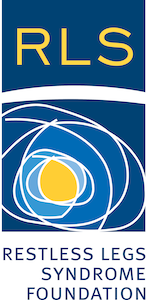
Restless Legs Syndrome
At a Glance
- Restless legs syndrome (RLS) is a common neurological condition that affects sleep, general health, and quality of life.
- Symptoms of RLS include an overpowering urge to move the legs, accompanied by tingling, crawling, aching, or pulling sensations in the limbs.
- RLS is a complex condition in which brain iron deficiency, dysfunction in the brain’s dopamine system, genetics, and environmental factors interact to create symptoms.
- Treatment involves addressing the underlying cause (when possible), making specific lifestyle changes, optimizing iron levels, and using medication when needed.
Overview
Restless legs syndrome (RLS), or Willis-Ekbom disease, is a neurological condition defined by an overwhelming urge to move the legs, often accompanied by uncomfortable sensations that can intensify during periods of rest, especially at night.
Many people with RLS find short-term relief in moving their legs through walking, stretching, or even simple fidgeting. However, the discomfort of RLS and its compulsion to move can make it challenging to fall asleep or stay asleep, which in turn leads to daytime fatigue that can interfere with everyday life.
Doctors sometimes break RLS into two groups to help people understand their diagnosis:
- Primary RLS: Also called idiopathic RLS, primary RLS develops independently without being linked to another medical problem. It tends to run in families, meaning there can be a genetic component, and it usually begins at a younger age.
- Secondary RLS: An underlying condition or component that can be identified, such as iron deficiency, chronic kidney disease, diabetes, neuropathies, neurological disorders, pregnancy, and certain medications, triggers secondary RLS. It often comes on more suddenly and begins later in life.
What causes restless legs syndrome?
While the exact cause of restless legs syndrome (RLS) is not fully understood, symptoms likely occur due to a complex interaction between many factors.
Recently, several studies in animals and people have confirmed that iron deficiency in the brain is a partial cause of RLS. While iron deficiency can cause (secondary) RLS, even people who have normal iron levels in their bodies might have iron deficiency in the brain. This may be due to problems with iron transportation and metabolism.
Therefore, within certain limits, iron supplementation can be helpful for people with RLS who technically have “normal” blood iron levels.
Dysfunction in the brain’s dopamine pathways—the same pathways that control movement—also plays a major role. When dopamine pathways are not working correctly, the brain misfires movement signals, leading to the urge to move and uncomfortable sensations.
Doctors also believe that genetic factors play a role, as primary RLS can run in families. Up to 80 percent of people with RLS report a family history of the disease.
Secondary causes of RLS can include iron deficiency, kidney disease, specific medications, and pregnancy, all of which can worsen symptoms.


Restless Legs Syndrome Symptoms
The hallmark symptom of restless legs syndrome (RLS) is an irresistible urge to move the legs, often described as tingling, crawling, aching, or burning sensations deep within the limbs.
If you or someone you know has RLS, you may experience a combination of the following:
- Uncontrollable urge to move the legs: This symptom is a strong, often overwhelming need to move the legs when sitting down or resting, especially in the evening or at nighttime.
- Unpleasant leg sensations: People often describe these sensations as crawling, tingling, itching, pulling, creeping, burning, or aching feelings deep within their legs.
- Temporary relief with movement: Walking, stretching, or shifting position can ease your symptoms, but they generally return once movement stops.
- Symptoms that worsen during rest or at nighttime: The discomforting sensations of RLS tend to begin or worsen when you’re sitting still or lying down for long periods, and can become more noticeable when you go to bed.
- Difficulty falling or staying asleep: Because these symptoms are more prominent at nighttime, frequent awakenings or insomnia can occur.
- Involuntary leg movements during sleep: Periodic limb movements throughout the night, like the legs twitching or jerking, are also common.
- Daytime fatigue and sleepiness: Poor sleep quality leads to a lack of energy, chronic fatigue or sluggishness, and reduced concentration ability.
- Mood changes and irritability: The chronic sleep disruption caused by these symptoms is known to contribute to irritability, anxiety, or depression.
While RLS symptoms most commonly affect the legs, they can occasionally affect the arms. The severity of these symptoms can range from mild and occasional discomfort to severe and persistent symptoms that significantly affect your quality of life.
Restless Legs Syndrome Diagnosis
Diagnosing restless legs syndrome (RLS) is based on your history and description of symptoms rather than a single definitive test. In general, healthcare professionals will look for five main criteria for diagnosis (think: URGES):
- U: An uncontrollable urge to move the legs
- R: Symptoms that begin or worsen during rest
- G: Gets better with movement
- E: Worsening symptoms in the evening or at night
- S: Symptoms that are hard to describe
Your doctor might use the following exams, tests, and imaging tests in the process of diagnosing RLS:
- Physical and neurological exam: First, your healthcare provider will ask about your symptoms in detail, as well as your overall health and family history. Next, they’ll complete an examination to assess your neurological function, including reflexes, coordination, strength, and sensation, to check for other possible explanations, like peripheral neuropathy or arthritis.
- Blood tests: Blood tests are often ordered, as brain iron deficiency is a known contributor to RLS. Additional lab work may be done to rule out kidney disease, diabetes, or vitamin deficiencies that could cause similar symptoms.
- Sleep study: In some cases, your doctor may recommend a sleep study to evaluate the impact of RLS on your sleep patterns. However, this is not required for diagnosis.
Ultimately, an RLS diagnosis is made based on your description of symptoms and exclusion of other conditions.

Restless Legs Syndrome Treatments
All treatments for restless legs syndrome (RLS) are nonsurgical. Management focuses on addressing the underlying causes when possible, making specific lifestyle changes, and, if necessary, incorporating medication.
For mild cases of RLS, lifestyle modifications and self-care strategies can be a very effective treatment. These include:
- Regular exercise: Moderate activity like walking, cycling, or yoga improves blood flow, reduces muscle tension, and helps regulate dopamine function in the brain.
- Stretching and massages: Gentle stretches or massaging the legs relaxes your muscles, eases discomfort, and provides temporary relief from the urge to move.
- Applying heat or cold: Warm baths, heating pads, or cold packs can soothe abnormal nerve signals and reduce uncomfortable leg sensations.
- Practicing good sleep hygiene: Going to bed and waking up consistently in a cool, dark sleep environment can minimize nighttime flare-ups. Avoiding computer, TV, and phone screens before bed is also helpful.
- Limiting caffeine, alcohol, and nicotine: Because these substances act as stimulants or can disrupt sleep, they can lead to worsening symptoms, especially in the evening. Limiting their use reduces nervous system irritation.
- Stress management: Stress and anxiety are known to intensify RLS. Conversely, relaxation techniques like meditation, deep breathing, or mindfulness can calm the nervous system and lower the severity of your symptoms.
Dietary changes can ease your symptoms and reduce your risk of RLS flare-ups, such as consuming:
- Iron-rich foods: Researchers have linked iron deficiency to RLS. Lean red meat, chicken, turkey, liver, lentils, beans, spinach, and kale are rich in iron and can help increase its levels in your blood.
- Vitamin C–rich foods: Oranges, strawberries, bell peppers, and tomatoes are foods high in Vitamin C and improve iron absorption when eaten with iron-containing foods.
- Folate-rich foods: A folate deficiency can worsen symptoms of RLS. Dark leafy greens, avocados, asparagus, and fortified grains are good sources of folate.
- Magnesium-rich foods: Almonds, cashews, bananas, pumpkin seeds, and whole grains are rich in magnesium, which supports muscle and nerve function.
- B-vitamin sources: Eggs, fish, poultry, and whole grains are strong sources of Vitamin B. Deficiencies of B vitamins—especially B12—can contribute to nerve problems.
- Plenty of water: Staying hydrated can help reduce muscle cramping and restlessness.
- Smaller meals at night: Eating smaller, balanced meals in the evening can also be helpful, as large or heavy dinners may worsen nighttime symptoms.
Doctors generally recommend medications when your RLS symptoms are moderate to severe or disruptive to your life. Careful medication selection is critical for people with RLS, as some can cause side effects or worsen symptoms over time. Medications prescribed for RLS can include:
- Alpha-2-delta ligands: To calm overactive nerve signals or painful or uncomfortable sensations, your physician may prescribe medications like gabapentin, gabapentin enacarbil (Horizant), or pregabalin. These medications are now considered first-line for the medical management of RLS. They are invaluable for those with painful RLS sensations, insomnia, or coexisting conditions like neuropathy.
- Iron replacement therapy: Doctors often prescribe oral or IV iron supplementation to raise brain iron levels. Proper iron supplementation use is the most overlooked aspect of RLS management.
- Low-dose opioids: In severe or treatment-resistant cases, opioids may be used, but they carry a risk of dependence as well as additional side effects. For that reason, long-acting opioids such as methadone and buprenorphine, which may have a better safety profile than shorter-acting opioids (morphine, oxycodone, etc), are preferentially used and have been found to be safe.
- Benzodiazepines and related sedatives: While these medications don’t treat RLS directly, they can aid in falling asleep, and doctors generally prescribe them for short-term support.
- Device-aided therapy: High-frequency noninvasive peroneal nerve stimulation, marketed as Nidra, can help reduce symptoms of RLS, similar to the effect experienced from walking.
- Dopaminergic drugs: These medications were previously considered first-line treatments for RLS. However, because they can augment or worsen RLS symptoms, routine use of dopaminergic medications is not recommended. Examples include pramipexole, ropinirole, rotigotine, and levodopa.
Common Questions
How common is restless legs syndrome?
In the U.S., researchers estimate that seven to 10 percent of the population experiences restless legs syndrome (RLS), to varying degrees. Around two to three percent of adults experience moderate to severe symptoms of RLS.
Worldwide, the prevalence of RLS varies between three and 10 percent, depending on the population—for example, higher rates of RLS are generally reported in North America and Europe compared to Asia.
Who gets restless legs syndrome?
Restless legs syndrome (RLS) can occur at any age, but diagnosis is more common in middle-aged and older adults. Women are nearly twice as likely to develop RLS as men, and RLS symptoms can be common during pregnancy, particularly in the third trimester.
Genetics also plays a critical role, as nearly 80% of people with RLS report a family history of the condition.
What is the prognosis for someone with restless legs syndrome?
The prognosis for someone with restless legs syndrome (RLS) depends on whether the condition is primary or secondary and the severity of the symptoms.
Primary RLS is usually a lifelong condition. Symptoms often worsen with age, although the rate of progression varies from person to person. While it can’t be cured, primary RLS can usually be managed with lifestyle changes and medication when needed. With proper treatment, most people with primary RLS are able to control their symptoms well enough to maintain a good quality of life.
The outlook tends to be better for those with secondary RLS. If the underlying cause, like iron deficiency, can be identified and treated, symptoms can improve significantly or resolve completely.
In general, RLS is not life-threatening, but it is considered a chronic neurological disorder that can substantially affect sleep, health, and well-being if left untreated. Early recognition and proper management remain key to improving long-term outcomes.
Can restless legs syndrome be prevented?
Restless legs syndrome (RLS) cannot be entirely prevented, especially in cases of primary RLS. There is no known way to prevent primary RLS from developing in individuals predisposed to the condition due to genetics or an unclear external cause.
However, secondary RLS can occasionally be prevented by addressing the following modifiable health factors:
- Iron deficiency: Maintaining adequate iron intake through your diet or through supplements when needed can reduce your risk.
- Chronic health conditions: Managing kidney disease, diabetes, or neuropathies may help lower your chance of secondary RLS.
- Pregnancy-related RLS: While common in the third trimester, pregnancy-related RLS symptoms can be helped by monitoring iron and folate levels.
- Medication use: Avoiding or minimizing drugs that can worsen RLS, like specific antihistamines, antidepressants, or antipsychotics, can be worth discussing with a trusted healthcare professional.
Even when RLS cannot be prevented, adopting healthy and sustainable lifestyle practices, like regular exercise, a balanced diet, stress reduction, good sleep hygiene, and limiting caffeine, alcohol, and nicotine, can decrease the likelihood of symptoms worsening or becoming disruptive.



